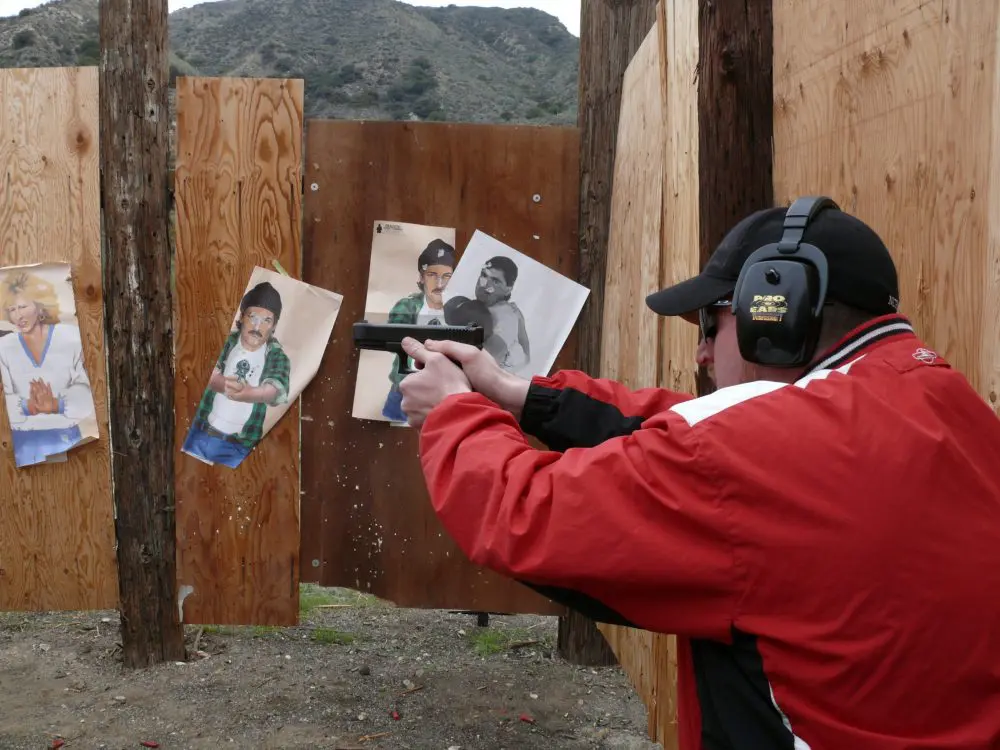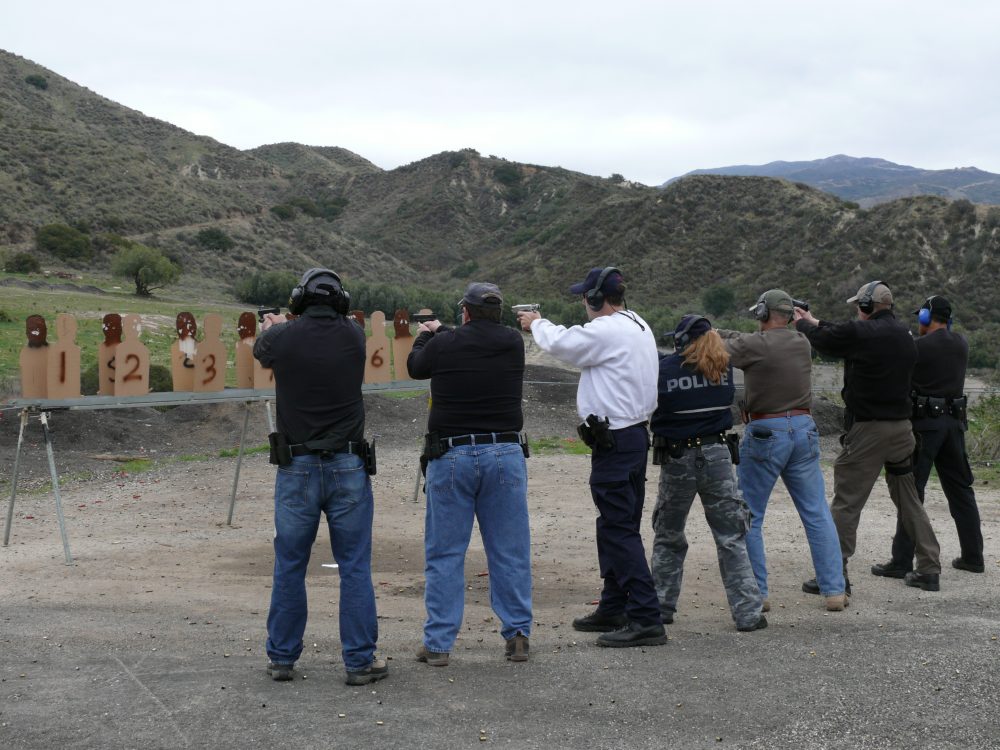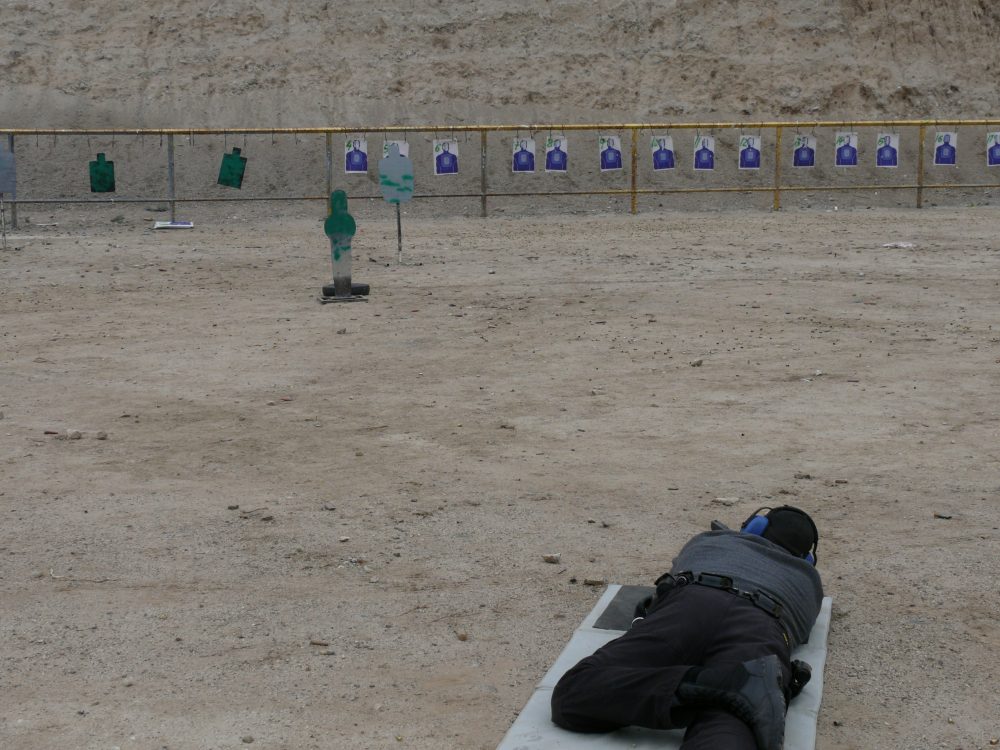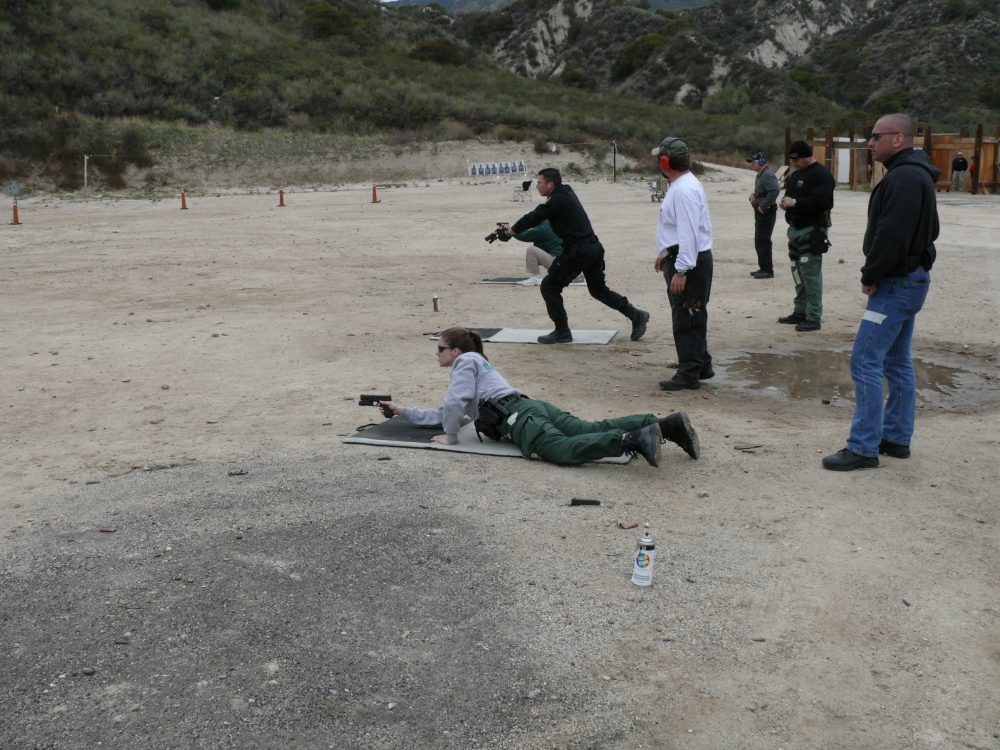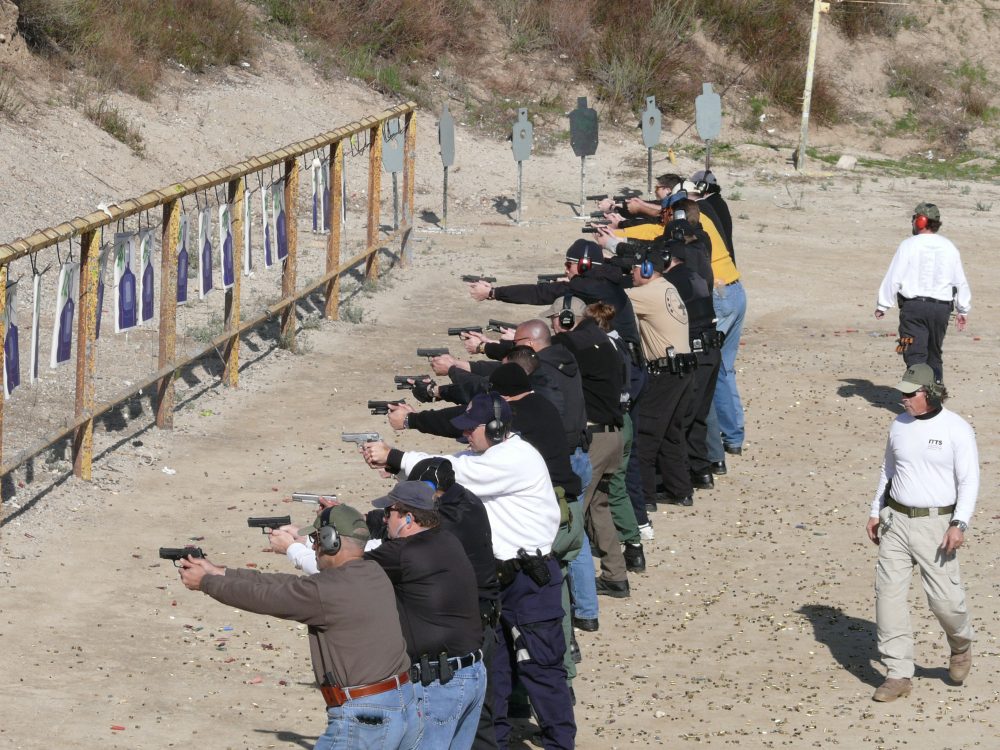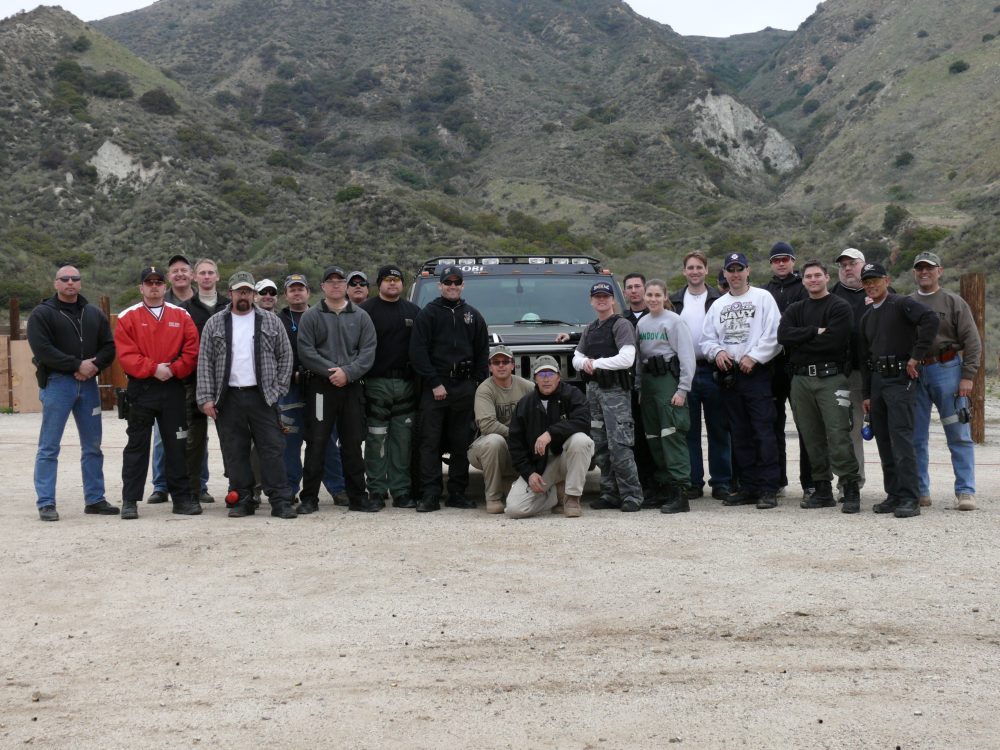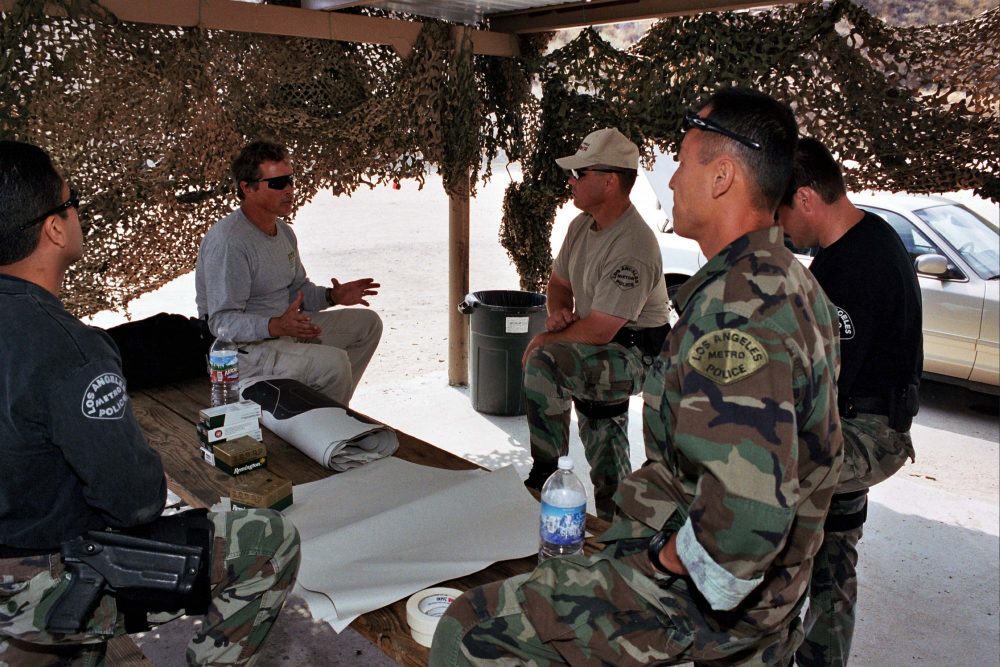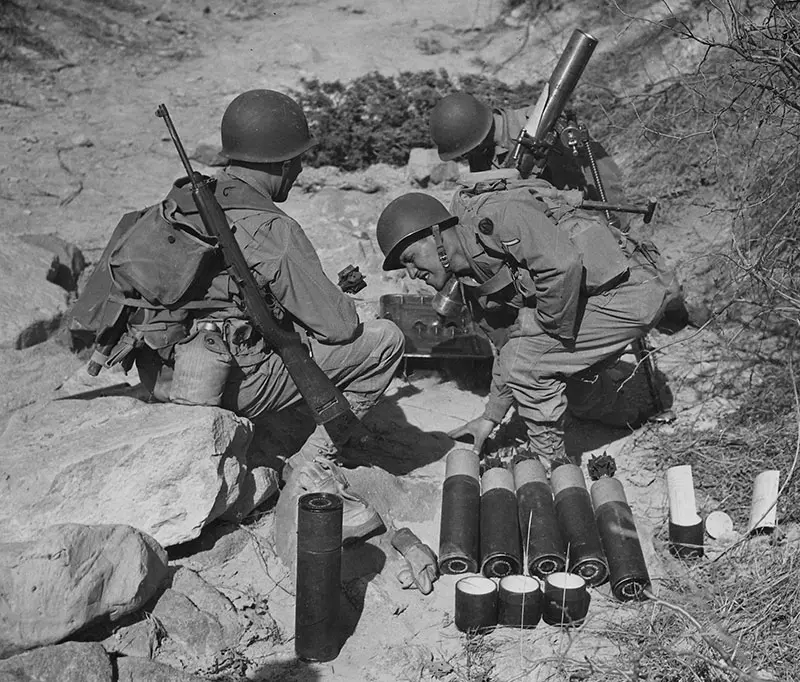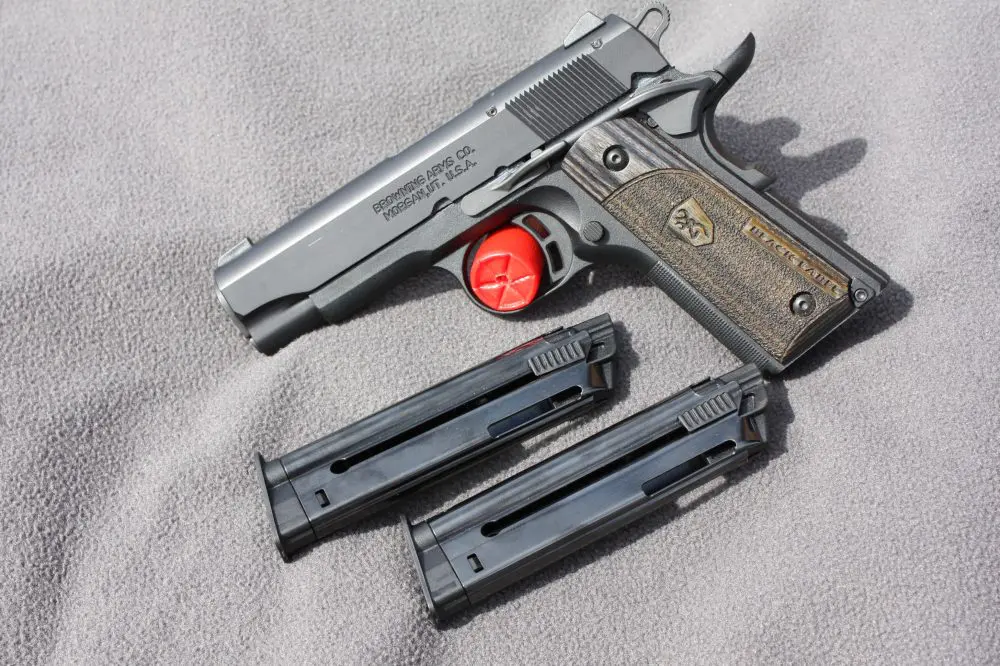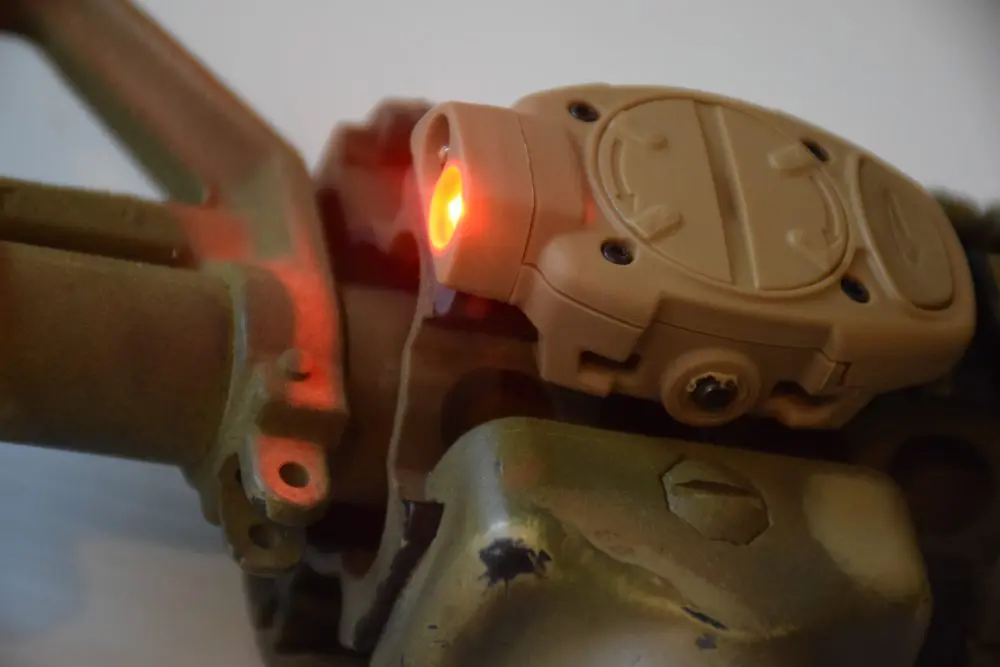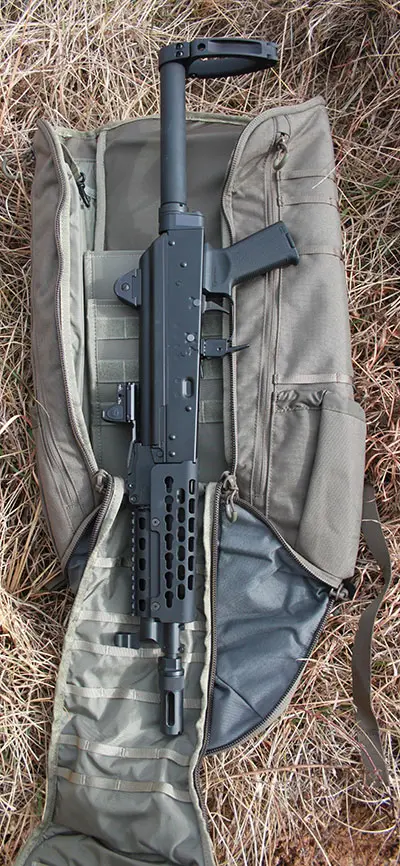Another beautiful, balmy Friday dawns on southern California as Scott Reitz, head instructor and co-founder of International Tactical Training Seminars (ITTS), begins his lecture. It’s a typical February day in California at the Angeles Shooting Range, located just north of Los Angeles in the foothills of the San Gabriel Mountains. Warm sunshine, a light breeze, and the soothing sound of ocean waves crashing in the distance. Okay, I admit, maybe it was a little cold—can you say “wind chill”? Scott is explaining the secret to Tiger Woods’ golfing success, and how this relates to gunfighting…
Over the next three days, this seminar will advance from a review of handgun manipulation and marksmanship basics to high-speed tactical drills.
One of a kind hostage rack develops shooters’ hostage resolution skills on many levels.
Starting with a review of the five-point draw from the holster, shooting on paper and steel targets at various distances, speed reloading, and malfunction drills, the course then picks up speed and progresses to one-handed shooting, braced/unbraced kneeling and prone firing positions, steel hostage targets and multiple steel target evolutions, and shooting under low-level light conditions.
Finally, we are introduced to some of the more advanced drills Scott has created, including shooting on a laterally moving target, shoot/no-shoot room clearance, night-shooting on the Donga trail, entering into a hostage scenario with tactically correct deportment, firing on ITTS’s uniquely designed hostage rack, and finally, a timed obstacle course completed while coordinating with a partner. The overarching theme: how to successfully flow and think your way through a gunfight.
ITTS shoot house forces students to make quick decisions when applying deadly force.
From the very basic to the most advanced ITTS courses, the core elements of shooting—what gunfighting comes down to in the end—are heavily emphasized. This course is no exception. The physical and mental aspects of drawing and firing your weapon—sight alignment, trigger press, follow through, sight alignment, trigger press, follow through—are ingrained in you as you progress from slow, shaky and deliberate to smooth and rehearsed, until finally you are flowing through each stage at speed.
This core process can only be learned through practice, and while training with Scott you will approach it from two directions: 1) starting slowly and deliberately and trying to increase your speed while maintaining your accuracy, and 2) getting on target as fast as you can and making a gentle trigger press, trying to increase your accuracy while maintaining your speed.
Sometimes field situations require shooter to go to prone position.
Being a student in an ITTS seminar, you often feel as if you are in a private lesson. Scott and his handpicked instructors are constantly giving you feedback and instruction that is tailored to your individual background and skill level. Whether you are a novice or a seasoned, high-speed operator, Scott and his cadre will find the right intensity level for you and then push you to your limit—and beyond. The training is also constantly evolving, dynamically changing based on the feedback of real-world operators (many trained by Reitz) who are constantly conveying to Scott the lessons they have learned in real gunfights around the world. At ITTS you learn what has been proven to work on the street.
Safety in training is of paramount importance at ITTS, and it is probably the only training program worth its salt that has an unblemished safety record. After training thousands of individuals over the years, from raw beginners to SWAT units to U.S. Special Forces operators, from the most basic to the most complex and high-speed evolutions, ITTS has never had one serious injury. Ever. And this is as it should be, regardless of skill level.
Rapid acquisition of positional shooting is taught to students.
Eventually, as you begin mastering the core physical, mechanical sequence, your shooting will begin to flow smoothly, but this involves more than the physical shooting process. Correct shooting involves adapting to the moment. As this larger psychological aspect of shooting is mastered, as you begin to smoothly coordinate your thought and action, both speed and accuracy begin to sharply increase, and you are ready to begin learning what real gunfighting is all about.
Scott also teaches much that goes beyond mechanical drills and tactical evolutions, and it’s not easy to put into words. ITTS is unique in that, beyond the technical aspects of firing a weapon accurately, beyond working through an evolution with surgical precision and speed, beyond imparting to students the tactical mindset needed to get through a gunfight safely and righteously, there is an underlying “way of the gun” taught by Scott. It is a philosophy of gunfighting—and one could say living—that Scott tries to instill in his students. This is not some new-age soul stroking I’m talking about. This “way” gets down to the very essence of being in a brutal, ugly gunfight—being in the moment of life-or-death and surviving. It is an essential and practical “way of the gun” to live by, and hopefully keep you and those around you alive, when the balloon goes up and a firefight is unavoidable.
Basics are constantly honed throughout all ITTS classes.
I find this—philosophy that is at the heart of gunfighting—very similar to the concept of seisha seichu (correct shooting is correct hitting) found in the style of Japanese Archery called Kyudo (aka “Zen archery”). Kyudo is heavily influenced by Zen Buddhism in that each arrow is shot as if it were the only one, analogous to living each moment of one’s life as if it were the only moment, the ultimate moment of existence.
And, as with anything “Zen,” there are many “koans” used to try to define the indefinable (example: “the sound of one hand clapping”). One Zen koan states that the Kyudo archer “does not look at the target for the result of his or her practice, but inward, for the target is not a target—it is a mirror.” Yeah, well, I don’t think anyone’s going to be reflecting on that idea during a firefight, but still, the concept is that the mind and body must be working together, within the shooter, to bring into effect the “correct shot” out there in the world. A missed shot reflects a missed connection within. Or something like that…
By the end of class, students’ skills and comprehension of tactics are markedly developed and everyone has had a great time!
Scott continually tries to impart this idea of being in the moment of the shot to us, as well as the related concept of “flowing,” often quoting Bruce Lee, who has stated this idea quite cogently: “Empty your mind, be formless, shapeless—like water. If you put water in a cup it becomes the cup, if you put it into a bottle it becomes the bottle. You put water into a teapot and it becomes the teapot. Now, water can flow or it can crash. Be water and flow, my friend.”
Fluidity and flowing are important concepts to Scott, and these are often discussed during his seminars, applying to everything from understanding and engaging a life-threatening confrontation, to the seamless flow of thought translated into action, to the flow from one mechanical step of the physical firing process to the next—sight alignment, trigger press, follow through, sight alignment, trigger press, follow through.
In addition to the physical mechanics of shooting, “flowing” applies to your thoughts, reactions and actions in a hostile situation—your ability to adapt and become the problem in an instant, to “become the teapot when flowing into a teapot.” You must adapt to each unique situation as you encounter it. A real-life hostile encounter will never, ever, involve a pre-planned series of steps that you know beforehand and can prepare for ahead of time. The route that you will flow through in each unique situation isn’t known until you’ve gone through it and it’s finished.
Reitz clearly communicates his philosophy to all students, from novices to experienced operators.
To prepare for a gunfight is to prepare to adapt, to be able to smoothly flow in the moment, mentally and physically, to be ready and able to adapt to unknown situations and unknown hostiles under all circumstances: when you’re exhausted, under extreme stress, in poor and/or unexpected lighting or weather conditions, perhaps even while severely injured or dying.
In the advanced ITTS seminars, after you’ve learned the correct basics of marksmanship, speed, accuracy, and what constitutes a righteous, legal gunfight, after you are able to go home and hone your speed and accuracy with a pistol on the range, and above all, after you’ve learned how to safely train, then you are ready to get down into the thick of it. At the higher levels of ITTS gunfighting instruction, it’s all about ingraining the basics while simulating as much as possible, as safely as possible, the unexpectedness and uncertainty of a real-world life-or-death encounter. This is the primary emphasis of Scott’s newly developed “Problem-Solving Tactics” course, which will give students even more experience in adapting to novel situations, flowing into and becoming the shape of whatever is presented to them, and reacting quickly, decisively, accurately and righteously.
This type of training is crucial in preparing for a real-life gunfight. This is where the training for “competition” shooting and actual gunfighting begins to diverge. If you’re not trained and prepared for the latter, you’re going to be in a world of hurt when the manure hits the fan, regardless of how quickly and accurately you can fire your weapon at a row of static metal plates on a bright, sunny day.
Words do not do the ITTS seminars, or Scott Reitz, justice—you must experience these courses to fully comprehend and appreciate their quality. Scott Reitz is truly a master gunfighter, but in addition to his years of experience as an operator and instructor in LAPD’s elite Metro Division and SWAT, and the depth of knowledge and skill this allows him to draw on, his ability to teach is also unsurpassed. Everything from his understanding of all aspects of weaponry and the essence of a gunfight on levels most instructors will never attain; to his knack for spotting and correcting errors in his students with constructive criticism;, to his ability to make his lectures interesting and focus on the most serious, pertinent points in an understandable way; to the humor, charisma and camaraderie he brings to each class; to his razor-sharp wit and style, Scott Reitz is the best gunfighting instructor you’re ever likely to encounter.
I give ITTS my highest recommendation to anyone wanting to learn the best skills from the best teachers. Whether you are a high-speed operator or a novice, you will be hard-pressed to find a better training program out there. Period.
SOURCE:
International Tactical Training Seminars
Dept. S.W.A.T.
149 South Barrington Avenue
Los Angeles, CA 90049
(310) 471-2029
www.internationaltactical.com
